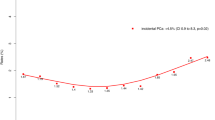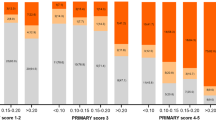Abstract
To evaluate prostate cancer (PCa) detection and incidence of pathologically insignificant PCa (pIPCa) tumour using percent-free PSA (%f-PSA) in patients with total PSA ⩽10 ng ml−1. From February 2002 to October 2009, 14 453 patients (median 60.5 years) were enrolled in a case-finding protocol for the early diagnosis of PCa. Indications to biopsy were suspicious digital rectal examination; PSA >10 ng ml−1; PSA⩽2.5 ng ml−1, included between 2.6–4 and 4.1–10 ng ml−1 with %f-PSA <15, <20 and <25%, respectively. A median of 18 and 26 cores in case of primary and repeated biopsy were determined; 2123 men underwent prostate biopsy, of whom 1589 (74.8%) had a PSA ⩽10 ng ml−1. A PCa was found in 777 (36.6%) and in 35 (23.3%) patients at primary and repeated biopsy: 459 and 26 men had PSA ⩽10 ng ml−1 and 419 and 26 patients underwent surgery, respectively, 244 (58.3%) and 18 (69.2%) had an organ-confined PCa with a pIPCa incidence equal to 1.4 and 7.7%, respectively. Cancer detection rate of 28.8% in patients with PSA ⩽10 ng ml−1 associated with a low incidence of pIPCa should induce to introduce %f-PSA in screening programmes to reduce the risk of overdiagnosis.
This is a preview of subscription content, access via your institution
Access options
Subscribe to this journal
Receive 4 print issues and online access
$259.00 per year
only $64.75 per issue
Buy this article
- Purchase on Springer Link
- Instant access to full article PDF
Prices may be subject to local taxes which are calculated during checkout
Similar content being viewed by others
References
Schroder FH, Hugosson J, Roobol MJ, Tammela TLJ, Ciatto S, Nelen V et al. Screening of prostate cancer mortality in randomized European study. N Engl Med 2009; 360: 1320–1328.
Andriole GL, Crawford ED, Grubb RL, Buys SS, Chia D, Church TR et al. PLCO Project Team: mortality results from a randomized prostate cancer screening trial. N Engl J Med 2009; 360: 1310–1319.
Bartsch G, Horninger W, Klocker H, Reissigl A, Oberaigner W, Schonitzer D et al. Prostate cancer mortality after introduction of prostate-specific antigen mass screening in the Federal State of Tyrol, Austria. Urology 2001; 58: 417–424.
Labrie F, Candas B, Cusan L, Gomez JL, Belanger A, Brousseau G et al. Screening decreases prostate cancer mortality: 11-year follw-up of the 1988 Quebec prospective randomized controlled trial. Prostate 2004; 59: 311–318.
Heijnsdijk EA, der Kinderen A, Wever EM, Draisma G, Roobol MJ, de Koning HJ . Overdetection, overtreatment and costs in PSA screening for prostate cancer. Br J cancer 2009; 1: 1833–1838.
Epstein J, Walsh P, Carmichael M . Pathological and clinical findings to predict tumour extent of non palpable (stage T1c) prostate cancer. JAMA 1994; 271: 368–374.
Aragona F, Pepe P, Motta M, Saita A, Raciti G, La Rosa P et al. Incidence of prostate cancer in Sicily: results of a multicenter case-findings protocol. Eur Urol 2005; 47: 569–574.
Pepe P, Aragona F . Prostate needle biopsy: 12 vs 18 cores. Is it necessary? Urol Int 2005; 74: 19–22.
Pepe P, Aragona F . Saturation prostate needle biopsy and prostate cancer detection at initial and repeat evaluation. Urology 2007; 70: 1131–1135.
Bostwick DG, Grignon DJ, Hammond ME, Amin MB, Cohen M, Crawford D et al. Prognostic factors in prostate cancer. College of American Pathologists Consensus Statement 1999. Arch Pathol Lab Med 2000; 124: 995–1000.
Hugosson J, Aus G, Lilja H, Lodding P, Pihl CG . Results of a randomized, population-based study of biennal screening using serum PSA measurement to detect prostate cancer. Cancer 2004; 100: 1397–1405.
Greene KL, Albertsen PC, Babaian RJ, Carter HB, Gann PH, Han M et al. PSA best practice statement 2009 update. J Urol 2009; 182: 2232–2241.
Hoffman R, Clanon D, Littenberg B, Frank JJ, Peirce JCl . Using free-to-total PSA ratio to detect prostate cancer in men with nonspecific elevations of PSA levels. J Gen Intern Med 2000; 15: 739–748.
Chun FK, Hutterer GC, Perrotte, Gallina A, Valiquette L, Bernard F et al. Distribution of prostate specific antigen (PSA) and percentage free PSA in a contemporary screening with no evidence of prostate cancer. BJU Int 2007; 100: 37–41.
Capitanio U, Perrotte P, Zini L, Suardi N, Antebi E, Cloutier V et al. Population-based analysis of normal total PSA and percentage of free/total PSA values: results from screening cohort. Urology 2009; 73: 1323–1327.
D'Amico AV, Renshaw AA, Cote K, Hurwitz M, Beard C, Loffredo M et al. Impact of the percentage of positive prostate cores on prostate cancer-specific mortality for patients with low or favourable intermediate-risk disease. J Clin Oncol 2004; 22: 3726–3732.
Pepe P, Panella P, D'Arrigo L, Savoca F, Pennisi M, Aragona F . Should men with serum PSA<4 ng/ml and normal digital rectal examination undergo a prostate biopsy? Oncology 2006; 70: 81–89.
Stranne J, Damber JE, Fall M, Hammarsten J, Knutson T, Peeker R . One-third of Swedish male population over 50 years of age suffers from lower urinary tract symptoms. Scand J Urol Nephrol 2009; 43: 199–205.
Godley PA, Carperter WR . Case-control prostate cancer screening studies should not exclude subjects with lower urinary tract symptoms. J Clin Epidemiol 2007; 60: 176–180.
Author information
Authors and Affiliations
Corresponding author
Ethics declarations
Competing interests
The authors declare no conflict of interest.
Rights and permissions
About this article
Cite this article
Pepe, P., Aragona, F. Incidence of insignificant prostate cancer using free/total PSA: results of a case-finding protocol on 14 453 patients. Prostate Cancer Prostatic Dis 13, 316–319 (2010). https://doi.org/10.1038/pcan.2010.29
Received:
Revised:
Accepted:
Published:
Issue Date:
DOI: https://doi.org/10.1038/pcan.2010.29
Keywords
This article is cited by
-
Erectile dysfunction in 1050 men following extended (18 cores) vs saturation (28 cores) vs saturation plus MRI-targeted prostate biopsy (32 cores)
International Journal of Impotence Research (2016)
-
Preoperative findings, pathological stage PSA recurrence in men with prostate cancer incidentally detected at radical cystectomy: our experience in 242 cases
International Urology and Nephrology (2014)
-
Prostate biopsy: results and advantages of the transperineal approach—twenty-year experience of a single center
World Journal of Urology (2014)



